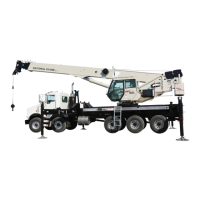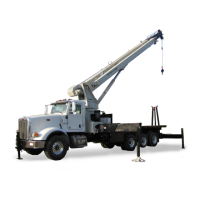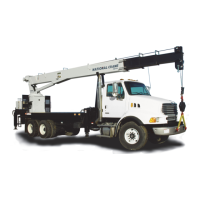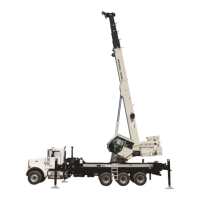4-20 3-29-2018 Control # 610-00
OPERATING CONTROLS - CRANE NBT40-1 SERIES OPERATOR MANUAL
sounds. Operator must immediately retract and lower boom
and place the boom in the boom rest and relevel the crane.
HOIST SYSTEM OPERATION
Hoist operation is not permitted in Aerial Lift Platform Mode.
Hoist may have lifting capabilities greater than that of
equipment limits. Therefore, care must be taken to ensure
that load lifted is within crane’s rating. General rules for hoist
operation are:
• Unwind hoist when extending boom.
• Use anti-two-block system only as an aid.
• Make sure hoist rope is not twisted or kinked and that it
is properly seated in hoist and in sheaves.
• Always have at least three full wraps of wire rope on
hoist and eight full wraps of synthetic rope (if equipped)
on hoist.
• Check hoist brake when approaching load limit of hoist.
Raise load a few inches and return control to neutral to
check brake.
• Do not drag load with hoist.
• Lift only freely suspended loads. Do not lift loads that
may be frozen to or otherwise secured to the ground.
• Keep tension on rope to prevent it from becoming
twisted, kinked, or improperly seated on hoist.
Hoist Two Speed Operation
High speed increases hoist line speed over normal
operation. High speed mode is activated by a switch (10,
Figure 4-3) located on crane operator’s cab.
.
To start high speed, depress high speed switch and operate
hoist lever on armrest. Refer to specification section of this
manual and Load Chart/Reach Diagram for more allowable
capacities.
COUNTERWEIGHT
NBT40-1 series is equipped with non-removable
counterweights as standard equipment. NBT36-1 is
equipped with a no-tailswing counterweight. Based on
chassis configuration there is a rotating optional
counterweight. See“Counterweight” on page 2-20.
WORK SITE LOCATION
Select a location that is firm, level, and dry. Avoid uneven,
rocky or muddy terrain, steep grade or locations with
overhead obstructions. Outrigger stabilizers must be
supported on a firm level surface at fully retracted, mid-span,
or fully extended positions. Avoid overhead power lines.
Before Leaving the Chassis Cab
• Position crane so that outriggers can be extended with
no obstructions.
• Position chassis transmission to neutral.
• Set chassis park brake. Wheel chocks may also be
required.
• Engage power takeoff.
• Turn chassis cab switch to OFF.
Stowing and Parking
When parking, crane should be left in smallest, most stable,
valid operational configuration the job site practically allows,
do following:
1. Park crane on a stable surface.
2. Remove load.
3. Stow swingaway boom extension, if erected.
4. Fully retract boom and position it in normal travel
position, then perform following and proceed to Step 6:
a. Engage swing brake and/or swing lock pin.
b. Retract all jack cylinders and outrigger beams.
5. If it is not practical to fully retract the boom and place it in
travel position, then perform following and proceed to
Step 6:
CAUTION
If high speed feature is run continuously or with an
overload, crane damage could occur.
DANGER
Chassis must be in neutral when starting engine from
operator’s control cab to avoid sudden potential
movement of chassis.
DANGER
Tipping Hazard!
Never park crane near holes, or on rocky or extremely soft
surfaces. This may cause the crane to overturn.
Failure to comply with these instructions may cause death
or serious injury.

